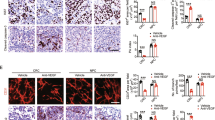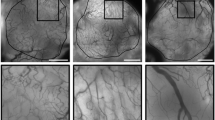Abstract
Background: Photodynamic therapy (PDT) is a promising therapeutic modality using a tumor localizing photosensitizer and light to destroy tumor cells. A major limitation of PDT is tumor recurrence, which is partly due to neovascularization. Purpose: The objective of the present study was to determine whether combination therapy with PDT and antiangiogenic agents (i.e. SU5416 and SU6668) would be more effective in controlling tumor recurrence in a mouse model of human CNE2 poorly differentiated nasopharyngeal carcinoma compared with PDT or antiangiogenic agents administered alone. Methods: Athymic mice bearing CNE2 tumor xenografts received daily i.p. injections of 20 mg/kg SU5416 or 100 mg/kg SU6668 for 28 consecutive days either alone or following a single hypericin-PDT treatment. Results: Significant inhibition of CNE2 tumor growth was observed in all treatment groups. Differences in 4× tumor growth time, the number of mice with 4× tumor growth, tumor growth inhibition as well as the percent of mice surviving were not statistically significant among individual treatment groups. However, the number of mice with 4× tumor growth observed in SU6668 monotherapy and combined PDT and SU6668 treatment groups was significantly less than that in the control group (P<0.05 and 0.01, respectively). Moreover, compared with the control group, only the combined PDT and SU6668 treatment significantly extended survival of tumor-bearing host mice (P<0.05). The semiquantitative RT-PCR results showed that the expression of HIF-1α, VEGF, COX-2 and bFGF were increased in PDT-treated tumor samples collected 24 h post-PDT, suggesting that PDT-induced damage to tumor microvasculature and the resultant hypoxia upregulate the expression of certain proangiogenic factors. Conclusions: The effectiveness of PDT can be enhanced by antiangiogenic treatment with the synthetic RTK inhibitors. Of the two synthetic RTK inhibitors tested, SU6668 was more effective than SU5416 in enhancing tumor responsiveness to PDT.




Similar content being viewed by others
Abbreviations
- bFGF:
-
Basic fibroblast growth factor
- CCE:
-
Choriocapillaris endothelial
- COX-2:
-
Cyclooxygenase-2
- FGFR1:
-
Basic fibroblast growth factor receptor-1
- GAPDH:
-
Glyceraldehyde-3-phosphate dehydrogenase
- HIF-1:
-
Hypoxia-inducible factor 1
- i.p.:
-
Intraperitoneal
- NPC:
-
Nasopharyngeal carcinoma
- PDGF:
-
Platelet derived growth factor
- PDGFR :
-
Platelet derived growth factor receptor
- PDT:
-
Photodynamic therapy
- RTK:
-
Receptor-associated tyrosine kinase
- TK:
-
Tyrosine kinase
- VEGF:
-
Vascular endothelial growth factor
- VEGFR-2:
-
Vascular endothelial growth factor receptor 2
References
Ausprunk DH, Folkman J (1997) Migration and proliferation of endothelial cells in preformed and newly formed blood vessels during tumor angiogenesis. Microvasc Res 14:53–65
Chan WS, Brasseur N, La Madeleine C, van Lier JE (1996) Evidence for different mechanisms of EMT-6 tumor necrosis by photodynamic therapy with disulfonated aluminum phthalocyanine or photofrin: tumor cell survival and blood flow. Anticancer Res 16:1887–1892
Chen B, Zupko I, de Witte PA (2001) Photodynamic therapy with hypericin in a mouse P388 tumor model: vascular effects determine the efficacy. Int J Oncol 18:737–742
Chen Q, Huang Z, Chen H, Shapiro H, Beckers J, Hetzel FW (2002) Improvement of tumor response by manipulation of tumor oxygenation during photodynamic therapy. Photochem Photobiol 76:197–203
Cross MJ, Dixelius J, Matsumoto T, Claesson-Welsh L (2003) VEGF-receptor signal transduction. Trends Biochem Sci 28:488–494
Denko NC, Fontana LA, Hudson KM, Sutphin PD, Raychaudhuri S, Altman R and Giaccia AJ (2003) Investigating hypoxic tumor physiology through gene expression patterns. Oncogene 22:5907–5914
Dimitroff CJ, Klohs W, Sharma A, Pera P, Driscoll D, Veith J, Steinkampf R, Schroeder M, Klutchko S, Sumlin A, Henderson B, Dougherty TJ, Bernacki RJ (1999) Anti-angiogenic activity of selected receptor tyrosine kinase inhibitors, PD166285 and PD173074: implications for combination treatment with photodynamic therapy. Invest New Drugs 17: 121–135
Dougherty TJ (1996) A brief history of clinical photodynamic therapy development at Roswell Park Cancer Institute. J Clin Laser Med 14:219–221
Dougherty TJ, Gomer CJ, Henderson BW, Jori G, Kessel D, Korbelik M, Moan J, Peng Q (1998) Photodynamic therapy. Natl Cancer Inst 90:889–905
Du HY, Bay BH, Olivo M (2003) Biodistribution and photodynamic therapy with hypericin in a human NPC murine tumor model. Int J Oncol 22:1019–1024
Ferrario A, von Tiehl KF, Rucker N, Schwarz MA, Gill PS, Gomer CJ (2000) Antiangiogenic treatment enhances photodynamic therapy responsiveness in a mouse mammary carcinoma. Cancer Res 60:4066–4069
Folkman J (1995) Tumour angiogensis. In: Mendelsohn J, Howley PM, Liotta MA (eds) Themolecular basis of cancer. WB Sanders, Philadelphia, pp 206–232
Fong TA, Shawver LK, Sun L, Tang C, App H, Powell TJ, Kim YH, Schreck R, Wang X, Risau W, Ullrich A, Hirth KP, McMahon G (1999) SU5416 is a potent and selective inhibitor of the vascular endothelial growth factor receptor (Flk-1/KDR) that inhibits tyrosine kinase catalysis, tumor vascularization, and growth of multiple tumor types. Cancer Res 59:99–106
Henderson BW, Dougherty TJ (1992) How does photodynamic therapy work?. Photochem Photobiol 55:145–157
Henderson BW, Vaughan L, Bellnier DA, van Leengoed H, Johnson PG, Oseroff AR (1995) Photosensitization of murine tumor, vasculature and skin by 5-aminolevulinic acid-induced porphyrin. Photochem Photobiol 62: 780–789
Itokawa T, Nokihara H, Nishioka Y, Sone S, Iwamoto Y, Yamada Y, Cherrington J, McMahon G, Shibuya M, Kuwano M, Ono M (2002) Antiangiogenic effect by SU5416 is partly attributable to inhibition of Flt-1 receptor signaling. Mol Cancer Ther 1:295–302
Kessel D (1990) HPD structure and determinants of localization. In: Kessel D (ed) Photodynamic therapy of neoplastic diseases. CRC, Boca Raton, pp 1–14
Laird AD, Vajkoczy P, Shawver LK, Thurnher A, Liang C, Mohammadi M, Schlessinger J, Ullrich A, Hubbard SR, Blake RA, Fong TA, Strawn LM, Sun L, Tang C, Hawtin R, Tang F, Shenoy N, Hirth KP, McMahon G, Cherrington JM (2000) SU6668 is a potent antiangiogenic and antitumor agent that induces regression of established tumors. Cancer Res 60:4152–4160
Laird AD, Christensen JG, Li G, Carver J, Smith K, Xin X, Moss KG, Louie SG, Mendel DB, Cherrington JM (2002) SU6668 inhibits Flk-1/KDR and PDGFRß in vivo, resulting in rapid apoptosis of tumor vasculature and tumor regression in mice. FASEB J 16:681–690
Lofgren LA, Hallgren S, Nilsson E, Westerborn A, Nilsson C, Reizenstein J (1995) Photodynamic therapy for recurrent nasopharyngeal cancer. Arch Otolaryngol Head Neck Surg 121:997–1002
Lukiw WJ, Ottlecz A, Lambrou G, Grueninger M, Finley J, Thompson HW and Bazan NG (2003) Coordinate activation of HIF-1 and NF-kappaB DNA binding and COX-2 and VEGF expression in retinal cells by hypoxia. Invest Ophthalmol Vis Sci 44:4163–4170
Lund EL, Bastholm L, Kristjansen PE (2000) Therapeutic synergy of TNP-470 and ionizing radiation: effects on tumor growth, vessel morphology, and angiogenesis in human glioblastoma multiforme xenografts. Clin Cancer Res 6:971–978
Mendel DB, Laird AD, Smolich BD, Blake RA, Liang C, Hannah AL,Shaheen RM, Ellis LM, Weitman S, Shawver LK, Cherrington JM (2000) Development of SU5416, a selective small molecule inhibitor of VEGFreceptor tyrosine kinase activity, as an anti-angiogenesis agent. Anticancer Drugs 15:29–41
Mendel DB, Schreck RE, West DC, Li G, Strawn LM, Tanciongco SS, Vasile S, Shawver LK, Cherrington JM (2000) The angiogenesis inhibitor SU5416 has long-lasting effects on vascular endothelial growth factor receptor phosphorylation and function. Clin Cancer Res 6:4848–4858
Nelson JS, Liaw LH, Orenstein A, Roberts WG, Berns MW (1988) Mechanism of tumor destruction following photodynamic therapy with hematoporphyrin derivative, chlorin, and phthalocyanine. J Natl Cancer Inst 80:1599–1605
Ning S, Laird D, Cherrington JM, Knox SJ (2002) The antiangiogenic agents SU5416 and SU6668 increase the antitumor effects of fractionated irradiation. Radiat Res 157:45–51
Peterson AC, Swiger S, Stadler WM, Medved M, Karczmar G, Gajewski TF (2004) Phase II study of the Flk-1 tyrosine kinase inhibitor SU5416 in advanced melanoma. Clin Cancer Res 10:4048–4054
Schouwink H, Oppelaar H, Ruevekamp M, van der Valk M, Hart G, Rijken P, Baas P, Stewart FA (2003) Oxygen depletion during and after mTHPC-mediated photodynamic therapy in RIF1 and H-MESO1 tumors. Radiat Res 159:190–198
Semenza GL (2000) Hypoxia, clonal selection, and the role of HIF-1 in tumor progression. Crit Rev Biochem Mol Biol 35:71–103
Shaheen RM, Davis DW, Liu W, Zebrowski BK, Wilson MR, Bucana CD, McConkey DJ, McMahon G, Ellis LM (1999) Antiangiogenic therapy targeting the tyrosine kinase receptor for vascular endothelial growth factor receptor inhibits the growth of colon cancer liver metastasis and induces tumor and endothelial cell apoptosis. Cancer Res 59:5412–5416
Sibata CH, Colussi VC, Oleinick NL, Kinsella TJ (2001) Photodynamic therapy in oncology. Expert Opin Pharmacother 2:917–927
Stadler WM, Cao D, Vogelzang NJ, Ryan CW, Hoving K, Wright R, Karrison T, Vokes EE (2004) A randomized Phase II trial of the antiangiogenic agent SU5416 in hormone-refractory prostate cancer. Clin Cancer Res 10:3365–3370
Star WM, Marijnissen HP, van den Berg-Blok AE, Versteeg JA, Franken KA, Reinhold HS (1986) Destruction of rat mammary tumor and normal tissue microcirculation by hematoporphyrin derivative photoradiation observed in vivo in sandwich observation chambers. Cancer Res 46:2532–2540
Stanbridge EJ, Nowell PC (1990) Origins of human cancer revisited. Cell 63:867–874
Tong MC, van Hasselt CA, Woo JK (1996) Preliminary results of photodynamic therapy for recurrent nasopharyngeal carcinoma. Eur Arch Otorhinolaryngol 253:189–192
Vajkoczy P, Menger MD, Vollmar B, Schilling L, Schmiedek P, Hirth KP, Ullrich A, Fong TA (1999) Inhibition of tumor growth, angiogenesis, and microcirculation by the novel Flk-1 inhibitor SU5416 as assessed by intravital multi-fluorescence videomicroscopy. Neoplasia 1:31–41
Weinberg RA (1989) Oncogenes, antioncogenes, and the molecular bases of multistep carcinogenesis. Cancer Res 49:3713–3721
Wenger RH, Gassmann M (1997) Oxygenes and the hypoxia-inducible factor-1. Biol Chem 378:609–616
Yu MC, Yuan JM (2002) Epidemiology of nasopharyngeal carcinoma. Semin Cancer Biol 12:421–429
Zangari M, Anaissie E, Stopeck A, Morimoto A, Tan N, Lancet J, Cooper M, Hannah A, Garcia-Manero G, Faderl S, Kantarjian H, Cherrington J, Albitar M, Giles FJ (2004) Phase II study of SU5416, a small molecule vascular endothelial growth factor tyrosine kinase receptor inhibitor, in patients with refractory multiple myeloma. Clin Cancer Res 10:88–95
Author information
Authors and Affiliations
Corresponding author
Rights and permissions
About this article
Cite this article
Zhou, Q., Olivo, M., Lye, K.Y.K. et al. Enhancing the therapeutic responsiveness of photodynamic therapy with the antiangiogenic agents SU5416 and SU6668 in murine nasopharyngeal carcinoma models. Cancer Chemother Pharmacol 56, 569–577 (2005). https://doi.org/10.1007/s00280-005-1017-0
Received:
Accepted:
Published:
Issue Date:
DOI: https://doi.org/10.1007/s00280-005-1017-0




